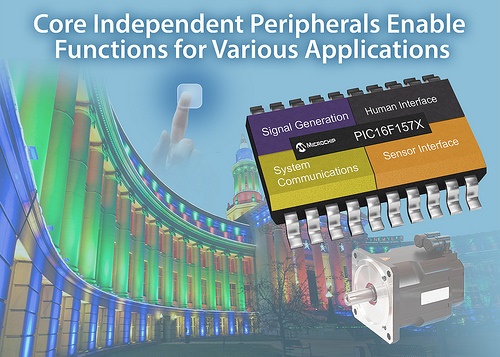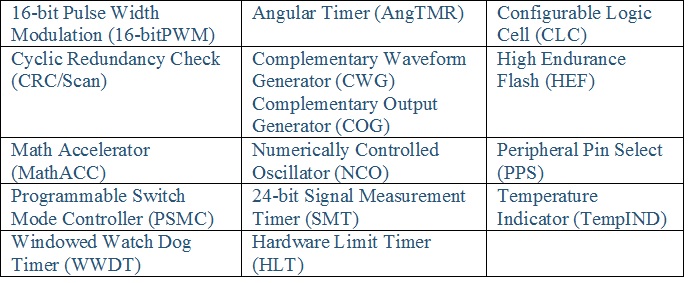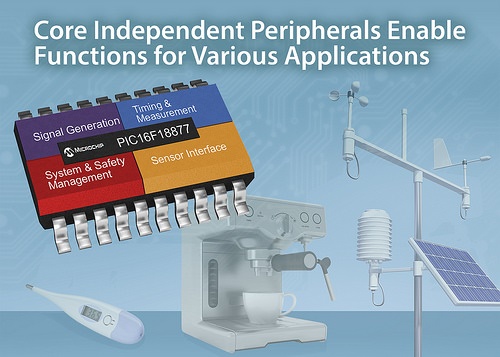The expanded family of PIC MCUs from Microchip offers Core-Independent Peripherals (CIPs) for use in broad range of applications, due to the growing number of these intelligent, interconnected CIPs that combine to perform functions autonomously, without the core. Because these functions are deterministically and reliability performed in hardware instead of software, CIPs increase syste m performance over typical 8-bit MCUs while reducing memory cost and simplifying design. Applications include consumer electronics, the Internet of Things (IoT), wearable technology, and safety-critical systems.
m performance over typical 8-bit MCUs while reducing memory cost and simplifying design. Applications include consumer electronics, the Internet of Things (IoT), wearable technology, and safety-critical systems.
The two new families, PIC16F1579 and PIC16F18877 are available in 8 to 40-pin packages, reducing board space while serving a wide 1.8 to 5.5V operating range. Both families offer the Peripheral Pin Select feature, which enables flexible pin mapping and PCB routing to minimize EMI and crosstalk.
The four new members of the PIC16F1579 Family are offered in 14 to 20-pin packages with up to 28 KB of Flash and feature CIPs that enable functions in a broad range of applications, such as LED lighting and motor control. They are the first 8-bit PIC MCUs with four 16-bit PWMs that each have independent timers, for flexible output and signal generation functions, including edge, center-aligned and other output modes. System-communication functions are supported via serial interfaces for LIN and DMX connectivity, while the family’s intelligent analog integration enables signal and sensor interface functions.
The first 10 members of the PIC16F18877 Family are available in 8 to 40-pin packages with up to 56 KB of Flash and feature CIPs that enable functions in a broad range of applications, such as consumer electronics, IoT and safety-critical systems. They are the first MCUs to integrate an ADC with computation, which performs input and sensor interface functions such as accumulation, averaging and low-pass filter calculations in hardware instead of software, enabling the CPU to Sleep or execute other tasks. They’re also the first PIC16 MCUs to augment Microchip’s eXtreme Low Power (XLP) technology with the IDLE and DOZE modes for reduced active power consumption. Additionally, they’re the first 8-bit MCUs with Peripheral Module Disable, which completely removes peripherals from the power rail and clock tree for zero power leakage. Other integrated CIPs, such as the Hardware Limit Timer, combine for the easy implementation of safety-critical functions.
Core-Independent Peripherals

Curiosity board eliminates heavy-lifting
The Curiosity Development Board (part # DM164137, $20) is available today to help jump-start system design. The freely downloadable MPLAB Code Configurator generates code with the click of a button. It provides a visual representation of an MCU’s peripherals, eliminating the need to read data sheets. Additionally, it allows user to setup CIPs easily and provides production-ready code, speeding the development efforts of both new and experienced users.
The devices are available today with pricing starting at $0.51 each in 10K-unit quantities.

Leave a Reply